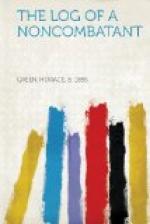A little later I managed to clamber on a river barge laden nearly to the sinking point with Antwerp’s peaceful burghers and their dumb-looking women and children. Slowly—very slowly—we steamed out of the haze of powder and oil-laden smoke, through long lines of gunboats and a flotilla of drifting scows packed to the gunwales like our own, and past Fort St. Philippe, whose garrison were at that moment heaving tons of powder into the river.
A few miles farther downstream they landed us on the northern bank of the Scheldt near the little town of Liefkenshack. Here I began a few miles of walking, occasionally varied by ox-cart locomotion.
I was traveling with nothing but a knapsack (my suitcase had to be abandoned) and therefore moving faster than the crowd. At one point, for the sake of company, I joined a group and took a turn at shoving the family wheel-barrow. They poured out thanks in the guttural Flemish tongue, then loaded me with bread and bits of mouldy pie. When that was not accepted they feared for their hospitality. They talked and I talked, with a result that was hardly worth the effort. Finally, after a conference, one of the group disappeared into the crowd and returned leading an eight-year-old boy.
“Me talk American,” said the boy. “We two speak together?”
And so we talked, for the road was long and weary.
Their advance was so gradual that, although I did not leave Antwerp until the bombardment was over, I caught up with the army of refugees before Roosendaal, just across the Dutch border.
Here Holland opened out her arms. The kindness of the Dutch—as yet personal, unorganized endeavor—was beyond conception.
Churches, houses, public halls, stations were thrown open to the multitude. You saw hundreds of Dutch soldiers join in the procession, lift babies and bundles, and walk with them for miles. At Dordrecht, when the trains came through, peasants passed scores of babies’ milk-bottles into the cars. When a jolly-looking Dutch girl, with a great big gleaming smile that reminded me of some one, gave me milk and chocolate, the tears began to trickle down my cheeks. I suppose it was the reaction, or because I was tired, or, perhaps, because the crowd was cheering and waving at us. For the others there were piles of bread, Dutch cake, and, best of all, some good, long drinks of water. For ten days Antwerp’s water supply had been cut off. Von Beseler, German siege commander, had seen to that.
At Bergen op Zoom and Roosendaal people used the walls of the houses for post-offices. They wrote their names in chalk letters, giving directions to relatives lost in the scramble.
After ox carts, rowboats, and river barges had done their share, a Dutch-Belgian “Stoom Tram” joggled us along for a few miles. Some more walking and a little running before I at last crawled aboard a twenty-car freight and passenger train moving slowly toward the east.




